"We are what we repeatedly do. Excellence, then, is not an act, but a habit." --Aristotle
Address any questions or comments regarding this newsletter to the individual authors listed after each article or to its editor, Rick Weinzierl, 217-333-6651, weinzier@illinois.edu. To receive e-mail notification of new postings of this newsletter, call or write the same number or address.
In This Issue:
Regional Observations (from Nathan Johanning, Mike Roegge, and Ellen Phillips)
Fruit Production and Pest Management (updates spotted wing Drosophila; brown marmorated stink bug)
Vegetable Production and Pest Management (corn earworm update, whiteflies on tomatoes in high tunnels; tomato russet mite, Phytophthora blight of cucurbits; weed management in organic vegetable production)
Local Foods Issues (GAPs audits – cost sharing is available)
Upcoming Programs
Check the Illinois SARE calendar for a full list of programs and links for registration.
http://illinoissare.org/ and http://illinoissare.org/calendar.php
Also see the University of Illinois Extension Local Food Systems and Small Farms Team’s web site at:
http://web.extension.illinois.edu/smallfarm/
- Is Entrepreneurial Farming for You? August 6, 2013, 5:30 – 9:00 p.m., University of Illinois Extension, Decatur, IL. This 3.5-hour workshop is designed to help people who think they might want to get their feet wet in sustainable farming learn what it takes to start and manage a farm-based business, and decide whether it is the path they are ready to take. For more information, https://webs.extension.uiuc.edu/registration/?RegistrationID=8540 .
- Driving and Maintaining Small Tractors, August 11, 2013, 2:30 – 6:00 p.m., Spence Farm, Fairbury, IL. Beginning farmers may lack experience with farm equipment which could be really useful to them – especially small tractors. This program will give you a hands-on experience with tractor safety and maintenance (and an opportunity to operate a small tractor). For more information, https://webs.extension.uiuc.edu/registration/?RegistrationID=7954
- Aronia Berry Field Day, August 28, 2013, 9:30 a.m. – noon. Coldbrook Farm, 16952 E 6000N Road, Momence, IL 60954. Register for this free event by calling University of Illinois Extension, Kankakee County at 815-933-8337 by August 27, 2013. For additional information, please email aronia.us@att.net or jtheu50@illinois.edu or visit www.coldbrookfarm.net.
Regional Observations
From southern Illinois...
Overall growing conditions have been very good in the southern part of the state. We were getting a little on the dry side in some areas, but the weather system that has come through last weekend and the early parts of this week brought the spotty showers to almost everyone at some point, keeping most crops content for water. Reports are very positive on the apple and peach crops in Southern Illinois, with Red Haven peaches coming in.
Local farmers markets are in full swing now, with a wide selection of produce. Field-grown tomatoes are coming on nicely, and some early melons also showing up on the markets. Pumpkins are off to a good start, benefiting from timely rains. No-till transplanted pumpkins after wheat are also looking good, although delayed some by the late wheat harvest. Plants are taking off, and vines will probably start to run in the next week. Squash bugs and cucumber beetles are common, so be watching for squash bug eggs on the upper and lower leaf surfaces of cucurbit crops. (See the July 15 issue of this newsletter for more information on these insects.)
With the benefits of timely rains also comes the appearance of new weed flushes. In southern Illinois waterhemp (and pigweeds), prickly sida, and hophornbeam copperleaf are still emerging and can still overtake many later planted crops such as pumpkins. Scouting for these weeds and managing them with whatever tools fit the crop is important as the summer continues. Remember … the smaller the weed, the easier it is to control!
Nathan Johanning (618-939-3434; njohann@illinois.edu)
From western Illinois...
The area received a general rain of 0.25 to 05 inches on July 21 … the first rain we’ve had since June 24 (and also the first rain this year that didn’t have any runoff associated with it). The lack of moisture, coupled with high temperatures, was starting to be felt as some of the crops that aren’t irrigated had started a downhill slide.
Early peach harvest has begun; blueberry picking continues, as does harvest of blackberries. Those with the capacity to irrigate have been keeping good fruit size; those without are seeing the results. Japanese beetles continue to plague certain areas and plants.
The hot weather has really advanced many crops. High tunnel tomato harvest is at a peak. Field tomatoes continue to mature, and first harvest has begun. Melons are close to harvest, and cucumber beetles have been present, so control has been ongoing. Bacterial wilt of cantaloupe has been identified. Pumpkins are beginning to flower.
Harvest of summer vegetables continues (sweet corn, green beans, zucchini, cucumbers, potatoes, summer squash, peppers , eggplant, onions, etc.). Tomato fruitworm/corn earworm damage has been significant in untreated tomatoes and sweet corn. We had some very high moth flights at the end of June and early July.
Corn earworm moth flight has begun to pick up again. I caught 2 moths on July 22, and then 10 the next day; these were the first since July 13. Aphids in tomatoes, peppers and vine crops continue to present problems.
Mike Roegge (217-223-8380; roeggem@illinois.edu)
From north central Illinois...
Cooler temperatures this week should help crops recover from the high heat last week. Sweet corn harvest is in full swing, with evidence of corn earworm damage. Bell Pepper and tomato harvest is going well, but blossom end rot is evident in some fields and high tunnels. Remember that maintaining adequate soil moisture and avoiding big swings in wetness-dryness is important to avoiding blossom end rot. Squash vine borer persists as a problem; see the July 15 issue of this newsletter for notes on its management. Some fall cole crops such as cabbage are beginning to be planted.
Ellen Phillips (708-449-4320; ephillps@illinois.edu)
Fruit Production and Pest Management
Updates on Spotted Wing Drosophila (SWD)
There is not a lot of news on this insect in Illinois, possibly because it does not thrive in hot weather, and until recently “hot!” has been a pretty good descriptor of weather throughout the state. Out traps in raspberries and blackberries at the University of Illinois Fruit Research Farm have continued to capture 3-5 SWD flies per week over the last couple of weeks, but there has not yet been a surge in counts. Do keep in mind that cooler temperatures will favor its population growth, and do not be lulled into thinking it will not be a problem in later berry crops. Check the last few issues of this newsletter and the MSU web site (http://www.ipm.msu.edu/invasive_species/spotted_wing_drosophila) devoted to it for more information.
Rick Weinzierl (217-244-2126; weinzier@illinois.edu)
Brown Marmorated Stink Bug
No, I’m not reporting any new detections or infestations of this insect in Illinois, but it is time to start looking for it again in earnest.
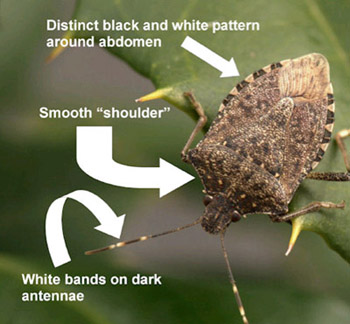
The characteristics that distinguish this stink bug from several other brown stink bugs are (1) white bands on the antennae, (2) a smooth margin at the front of the prothorax or “shoulder,” and (3) the alternating black and white pattern on the exposed part of the abdomen. If you think you have found this insect, collect specimens and send them to me in a crush-proof container … Rick Weinzierl, Department of Crop Sciences, 1102 South Goodwin Avenue, Urbana, IL 61801. Do not simply spray your orchard or field and then tell me that you controlled them … we need to see specimens and confirm your suspicions if we are to identify sites for control trials and help you develop a management plan.
Rick Weinzierl (217-244-2126; weinzier@illinois.edu)
Vegetable Production and Pest Management
Corn Earworm
Based on reports from Mike Roegge at Quincy and Dan Fournie at Collinsville, as well as observations from our traps at Urbana, corn earworm moth counts have dropped significantly since around July 10 and are slowly increasing again. I expect moth counts – and damage to untreated sweet corn and tomatoes – to increase quite a bit over the next 3 to 4 weeks. I’ll repeat the same recommendation that was in the previous issue of this newsletter … Sweet corn and tomato growers should be operating a cone-shaped pheromone trap for corn earworm and devising spray plans accordingly for the remainder of the summer. See “Preseason Reminders for Corn Earworm Management in Sweet Corn” in the February 20 issue of this newsletter for more information.
Rick Weinzierl (217-244-2126; weinzier@illinois.edu)
Whiteflies on High-Tunnel Tomatoes
Mike Roegge noted that whiteflies are an increasing problem on tomatoes in high tunnels. Growers who apply pyrethroids – such as Asana, Brigade, or Danitol (all labeled for whitefly control) or Baythroid, Mustang Max, or Warrior – often get some level of control with their first spray. However, significant portions of whitefly populations (either greenhouse whitefly or silverleaf whitefly), often are NOT susceptible to these pyrethroids, and infestations continue to build despite subsequent applications. Actara (0-day PHI), Assail (7-day PHI), Fulfill (0-day PHI), Movento (1-day PHI), Oberon (7-day PHI), and Provado (0-day PHI) are likely to be more effective. Be sure to check the bee-poisoning cautions on these products if bumble bees are used in the tunnels for pollination or if honey bees are present in tunnels. These alternative insecticides are fairly expensive, but a small container will last for a few seasons if used only one or two high tunnels … and the tomato crop in a 30 X 96-foot high tunnel should be worth thousands of dollars. For organic growers, M-Pede (insecticidal soap) and Neemix (neem) provide some control. Very thorough coverage is necessary for best results with M-Pede or Neemix.
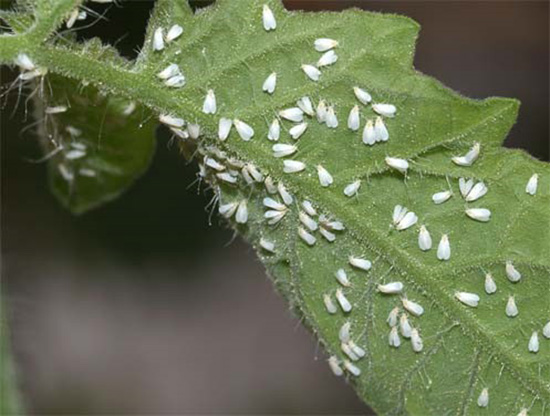
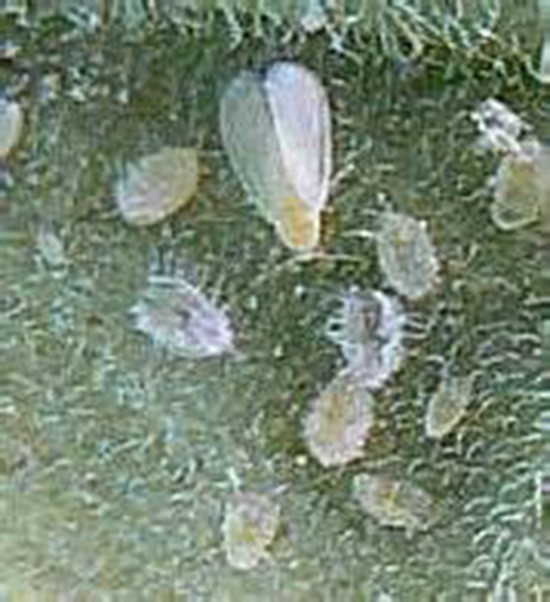
Whiteflies on tomato.
Rick Weinzierl (217-244-2126; weinzier@illinois.edu)
Tomato Russet Mite
The University of Illinois Plant Clinic recently received specimens of tomato plants infested with tomato russet mite. Tomato russet mite is smaller than two-spotted spider mite and is somewhat wedge- or cigar-shaped. The sample came from a home garden in northern Illinois, and the tomatoes were adjacent to petunias (often associated with russet mites), but it served as reminder to point out that most miticides are not very effective for russet mite control. Agri-mek and wettable sulfur are generally most effective against this pest.
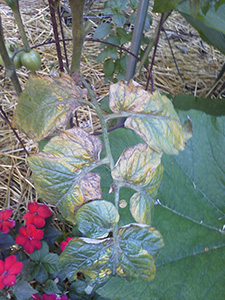
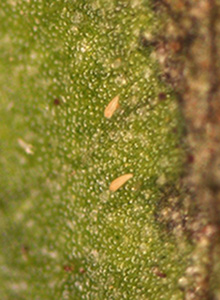
Tomato russet mite: symptoms and mites.
Rick Weinzierl (217-244-2126; weinzier@illinois.edu)
Phytophthora Blight of Cucurbits
Dan Egel of Purdue University wrote a very useful summary and update on Phytophthora blight of cucurbits in the most recent issue of Purdue’s Vegetable Crops Hotline. To see his photos and read his recommendations, see http://www.btny.purdue.edu/pubs/vegcrop/VCH2013/VCH572.pdf .
Weed Management in Organic Vegetable Production

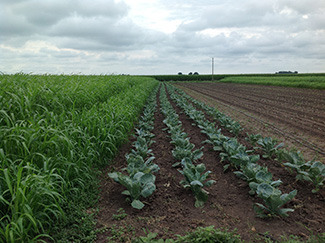
Results of flame weeding (left), and a stand of sudangrass used as a cover crop for subsequent weed control at blue Moon Farm.
On July 21 I had the opportunity to attend the “Many Seasons Weathered” tour of two veteran organic farms in Champaign County: Tomanhous Farm and Blue Moon Farm as part of the Illinois Organic Growers Association Summer/Fall Field Days. All growers contend with weeds, but organic farmers need to employ a wide variety of tools and strategies to control weeds using only cultural and mechanical methods. Some of the management goals for which vegetables farmers use cover crops include: suppressing weeds, protecting soil from rain or runoff, improving soil aggregate stability, reducing surface crusting, adding active organic matter to soil, breaking hardpan, fixing nitrogen and scavenging soil nitrogen. Both farms use cover crops to control weeds, and Blue Moon Farm had several areas planted to sudangrass. For more information about using this cover crop, see Sorghum-Sudangrass Hybrids for Cover Cropping in Organic Farming. Blue Moon Farm also used flame weeding. For more information about flame weeding, check out this excellent publication, Flaming as a Method of Weed Control in Organic Farming Systems.
Deborah Cavanaugh-Grant (217-782-4617; cvnghgrn@illinois.edu)
Local Foods Issues
Good Agricultural Practices - GAPs Audits
More and more markets are requiring Good Agricultural Practices (GAPs) Audits. GAPs has evolved to various levels of recognition by buyers. Many buyers simply want to know that farmers are aware of GAPs and a “Certificate for Training” from one of the University of Illinois Extension GAPs workshops satisfies their requirements. Others are also requesting to review the Food Safety Plan that is developed by the farm and may even want to visit the farm to see how it is being implemented. Public school systems, industrial buyers, and large-scale brokers and grocery stores are beginning to require a GAPs Audit. The buyer will often mandate the auditing organization. There are numerous 3rd party audit organizations, so it is important to know which one your buyer wants. The audit entails a farm visit where the auditor will walk through the farms Food Safety Plan, looking for compliance. Audits can be expensive, starting at about $1000. To assist with the cost of the audit, University of Illinois Extension received an Illinois Specialty Crops Block Grant to cost-share GAPs audits. To apply for the program you need to attend an Extension GAPs workshop. To learn more about the program, contact a Local Food System and Small Farm Educator from the list at the end of this newsletter.
Ellen Phillips (708-449-4320; ephillps@illinois.edu)
Less Seriously...
The annual “Register’s Great Bicycle Ride Across Iowa” (RAGBRAI) has been underway this week. A co-worker in Iowa passed along this story about photos inspired by the scenery that riders enjoy during the ride. The photos, dubbed “The Views of Iowa,” are captioned …
- Corn on the left, beans on the right.
- Beans on the left, corn on the right.
- Corn on the left, corn on the right.
- Beans on the left, beans on the right.
And yes, I know … photos of most of the views of Illinois could bear the same captions.
University of Illinois Extension Specialists in Fruit and Vegetable Production & Pest Management
Extension Educators – Local Food Systems and Small Farms |
||
Bronwyn Aly, Gallatin, Hamilton, Hardin, Pope, Saline, and White counties |
618-382-2662 |
|
Katie Bell, Franklin, Jackson, Perry, Randolph, & Williamson counties |
618-687-1727 |
|
Sarah Farley, Lake & McHenry counties |
847-223-8627 |
|
Nick Frillman, Woodford, Livingston, & McLean counties |
309-663-8306 |
|
Laurie George, Bond, Clinton, Jefferson, Marion, & Washington counties |
618-548-1446 |
|
Zachary Grant, Cook County | 708-679-6889 | |
Doug Gucker, DeWitt, Macon, and Piatt counties |
217-877-6042 |
|
Erin Harper, Champaign, Ford, Iroquois, and Vermillion counties |
217-333-7672 |
|
Grace Margherio, Jackie Joyner-Kersee Center, St. Clair County |
217-244-3547 |
|
Grant McCarty, Jo Daviess, Stephenson, and Winnebago counties |
815-235-4125 |
|
Katie Parker, Adams, Brown, Hancock, Pike and Schuyler counties |
217-223-8380 |
|
Kathryn Pereira, Cook County |
773-233-2900 |
|
James Theuri, Grundy, Kankakee, and Will counties |
815-933-8337 |
|
Extension Educators – Horticulture |
||
Chris Enroth, Henderson, Knox, McDonough, and Warren counties |
309-837-3939 |
|
Richard Hentschel, DuPage, Kane, and Kendall counties |
630-584-6166 |
|
Andrew Holsinger, Christian, Jersey, Macoupin, & Montgomery counties |
217-532-3941 |
|
Extension Educators - Commercial Agriculture |
||
Elizabeth Wahle, Fruit & Vegetable Production |
618-344-4230 |
|
Nathan Johanning, Madison, Monroe & St. Clair counties |
618-939-3434 |
|
Campus-based Extension Specialists |
||
Kacie Athey, Entomology |
217-244-9916 |
|
Mohammad Babadoost, Plant Pathology |
217-333-1523 |
|